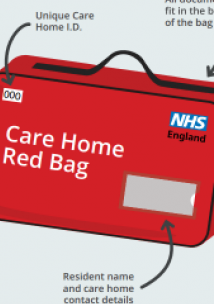Evaluating the Red bag project

The 'Red Bag' initiative is a new hospital transfer pathway for care homes residents in Lambeth and Southwark. The red bag is used to provide a prompt, safe and efficient transfer of clinical care, when a person moves between a care home and other clinical settings, such as hospitals.
During summer 2018 we spoke to people living in care homes and their families. The interviews were conducted with patients who were recently admitted to hospital with a red bag to explore how they found their hospital stay, their views on the red bag.
Report findings
Out of 90 survey responses from care home, London Ambulance Service and hospital staff, over two-thirds of respondents believed that the Hospital Transfer Pathway had improved communication between partners across the care pathway. Nearly all care home managers stated they were using the red bag and associated documentation all or some of the time and two-thirds of care home managers reported that residents returned from hospital with their documentation and belongings in the red bag. Over half of care home managers reported the pathway had improved the transfer process for residents.
However, hospital staff, paramedics and care home managers also highlighted challenges with the pathway. Standardised red bad documentation was sometimes missing or incomplete when residents were transferred to hospital, or lacked discharge information when residents were discharged back to the care home. There were particular difficulties in locating and retrieving bags that had become lost in hospital. In addition, both care homes and hospitals faced challenges with successfully promoting the pathway in the face of high turnover of staff and during the busy winter period.
The evaluation showed there was real enthusiasm and passion for the aims of the “Red Bag” Hospital Transfer Pathway from care home, ambulance and hospital staff. People involved believe it provides a valuable opportunity to improve the care of residents.
Respondents believed that communication had improved and the transition of care into and out of hospital was smoother, which was perceived to lead to improved quality of care. However, the evaluation also found that elements of the pathway have not been fully embedded within all individual professional practice and care settings.
When the pathway was not adhered to – either in the care home or hospital setting – this caused practical difficulties and could result in despondency and frustration amongst professionals.

